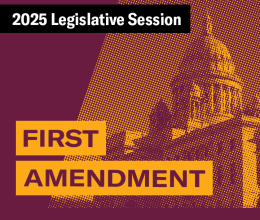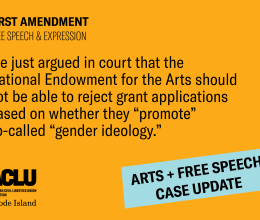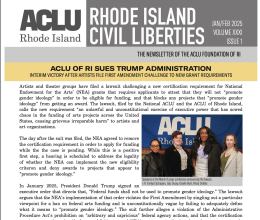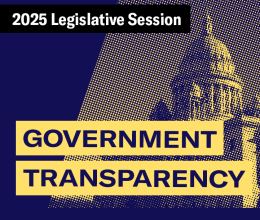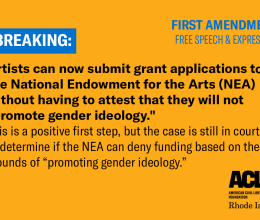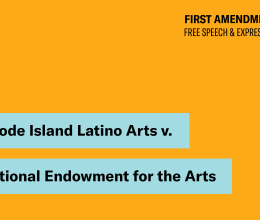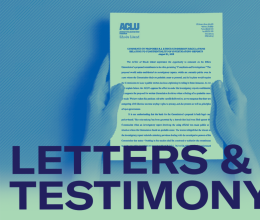The Rhode Island ACLU has asked a federal judge to preliminarily enjoin the City of Cranston from continuing to display a “School Prayer” mural addressed to “Our Heavenly Father” that is painted on a Cranston High School West auditorium wall. The request for interim relief, pending a final decision in the case, was filed by RI ACLU volunteer attorneys Lynette Labinger and Thomas Bender. The lawsuit, filed in April, is on behalf of Jessica Ahlquist, a sophomore at the school, who has been a vocal opponent of the prayer display.
In a 37-page memo accompanying the request, the ACLU brief notes that whenever Jessica “is required to attend an assembly in the auditorium, or when she chooses to attend extracurricular events, she is exposed to this prominent and large display. She has felt isolated, ostracized and devalued by her school and community because of the School Prayer.” In an affidavit accompanying the memo, Jessica describes how isolated she felt being in the auditorium for a mandatory school program last month where guest speaker Mayor Allan Fung offered his view, to loud applause, that the prayer should remain in the auditorium,
The ACLU’s brief emphasizes that:
The principle at the center of the [First Amendment’s] Establishment Clause is that government must remain neutral with respect to religion and religious practices, religion being a very personal matter of individual conscience. … As a consequence of a parent’s fundamental interest and right in the raising of his or her children, the principle of neutrality has been applied with great sensitivity and vigilance in the public school context, and the Supreme Court has made clear that a state is prohibited from sponsoring prayer in its elementary and secondary schools, because the Establishment Clause is abridged when the State affirmatively sponsors the particular religious practice of prayer.
Reviewing the history of prayer at Cranston High School West, the brief states that:
Tasking a student to write a “School Prayer,” organizing the students to recite it, and then authorizing a prominent painted display of the Prayer on the auditorium wall, all demonstrated Cranston’s intent to endorse and encourage its students’ belief in a divine being and to exercise the practice of “raising of one’s heart and mind to God” as part of their school experience. That was its purpose when installed in the early 1960s, and Plaintiff maintains, that is the predominant purpose of continuing to maintain its display today. However worthwhile that goal might have seemed then, or might seem to be today, it is not within the domain or authority of state or local government under the Establishment Clause: questions of religious belief and religious practice are for individuals, and, in the case of secondary school students, they are the responsibility and private domain of the family, and whatever religious community they may choose to be a part of – not public schools or their officials.
The brief cites from the U.S. Supreme Court’s decision in another Rhode Island school prayer case, Lee v. Weisman, that “school sponsorship of a religious message is impermissible because it sends the ancillary message to members who are nonadherents that they are outsiders, not full members of the political community, and an accompanying message to adherents that they are insiders, favored members of the political community. “School” prayers, whether recited, or silently but prominently displayed by the government on school property in school locations where students are required to be, violate this core First Amendment principle.”
Last July, after learning of the prayer mural, the ACLU wrote to school officials asking that it be removed. In the hope of avoiding litigation, the Affiliate and Ms. Ahlquist waited for the school committee to act. By a 4-3 vote in March, however, the school committee decided to keep the prayer, ignoring warnings about the cost of litigation and despite the school district’s ongoing and severe budgetary problems, which have led to layoffs and program cuts. The Rev. Dr. Donald Anderson, executive minister of the R.I. State Council of Churches, and Rabbi Peter Stein, who leads a congregation in Cranston, have also expressed opposition to the display, calling it “inappropriate” and “exclusionary.”
The lawsuit notes that the prayer, which is at least eight feet high and three feet wide, “is designed to be easily read by students attending programs in the auditorium.” The lawsuit alleges that Jessica Ahlquist “does not subscribe to the religious expression conveyed by the prayer and objects to being subjected to it as a requirement of attending school and a condition of attending school programs in the auditorium.”
The suit notes that a number of speakers at public hearings identified the prayer’s religious message as the reason for urging the school committee to maintain it, and also expressed anger and outrage at people like Jessica who questioned the prayer’s display. In fact, a day after the school committee’s March vote, Jessica was allowed to leave class early in response to concerns for her safety arising out of her opposition to the prayer.
The U.S. Supreme Court first ruled government-sponsored prayer in the public schools unconstitutional in 1962. Thirty years later, in the Lee v. Weisman case, the Supreme Court also ruled unconstitutional the recitation of prayers at public school graduation ceremonies.


